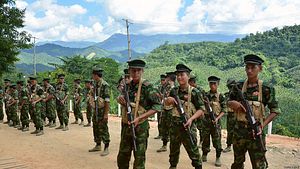In west Kachin state, a barefoot girl of no more than four years old is carrying her pink Hello Kitty backpack through the jungle’s shrubbery. The path she follows is one of well-trodden mud, interwoven with steps that are nearly taller than she is as she stumbles over them. It is 27 degrees. Her hair is cut short and her clothes are well-kept. She is tired but still screaming, a cry not yet familiar with the transience of internal displacement. Despite being the youngest of the girls she is with, she continues without stopping to be comforted. Her companion carries a half-full Frozen backpack in silence behind her.
These children are among tens of thousands of people displaced by violence in Myanmar’s northernmost Kachin state. A war between the central government in Yangon and the Kachin Independence Organization (KIO) has been raging since the withdrawal of the British empire in 1948. The state military, known as the Tatmadaw, ended the long-lasting ceasefire between the two in 2011, reigniting conflict with the Kachin Independence Army (KIA).
Forced disappearance, murder, detention, and systematic rape are all alleged tactics of the Tatmadaw in their program of counterinsurgency. This extends beyond Kachin into the neighboring Shan state, and the more recently publicized atrocities in Rakhine state in the west. As mass graves continue to be discovered in Rakhine, the world’s attention is pointedly fixed on the 688,000 Rohingya refugees who have crossed the border into Bangladesh since the latest outbreak of violence in August 2017. But 700 kilometers northeast of the Bangladesh border, another crisis continues to rage amid international silence.
The Tatmadaw has launched its winter offensive against the KIA and other ethnic minority separatist groups in northern Myanmar. Fighting has intensified, most notably in the Sumprabum, Waing and Tanai townships, with indiscriminate air strikes against alleged KIA locations leading to the deaths of at least five civilians so far this year.
A major air and ground offensive launched at the end of January trapped more than 3,000 villagers and migrant workers in the amber mining outlands of Tanai. The Tatmadaw established rigorous checkpoints, refusing civilian mobility at the peak of the violence, as many attempted to flee. Since then women, children, and some men (dependent on their ethnicity) have been allowed to leave the area but many others remain stranded – held under Tatmadaw “supervision.”
Some of those who have not been given permission to leave the areas affected by the ongoing aerial bombardment attempt to travel off-path through the jungle, risking their lives among the notorious landmines. Others that stay have had their phones confiscated by the military, and are experiencing the brunt of the food shortages created by the Tatmadaw’s strict regulations on rice and fuel transport. Aid workers have been refused access to the area, and the actual scale of the violence remains unknown.
Kachin state is an economically strategic location owing to its gold, amber, and jade reserves, which the KIO has been mining for export. In June 2017 the Tatmadaw used helicopters to drop hundreds of leaflets over the mining sites demanding that workers leave immediately, and declaring that anyone continuing to work in the mines would be considered an accomplice of the insurgents. Thousands fled from the mining townships into Tanai town, overwhelming the already strained resource of aid agencies to supply shelter and food. In the most recent offensive, the Tatmadaw has been successful at claiming some of the mines previously held by the TIO under the guise of protecting against environmental degradation.
While current peace talks are being hosted in China with representatives of the KIA and the Tatmadaw, China’s vested interest in infrastructural developments that would include developing transport links through Kachin state is one of the motivating factors for the Myanmar government’s renewed determination to stamp out separatists. China continues to profit too, from heavy arms sales to the Tatmadaw – while blocking attempts of those fleeing the violence to cross the border into China.
According to Yanghee Lee, the UN special rapporteur on Myanmar, the latest is nothing new. Lee’s most recent end of mission statement, published on February 1, notes recent reports of attacks against civilians, “against homes and places of worship, of forcible displacement and relocation; the burning of villages, land grabbing, sexual violence, arbitrary arrests and detentions, torture and enforced disappearances are acts that have been alleged against the military and security forces for generations.”
Lee also wrote: “I was told repeatedly by other ethnic groups I spoke to, be they Kachin, Karen, Kayin or Shan, that they have suffered the same horrific violations at the hand of the Tatmadaw over several decades, and in the case of some groups continuing today.”
“As the world’s attention is focused on the atrocities in Rakhine state,” Lee wrote, “potential war crimes are being committed in Shan and Kachin state without so much as a murmur of disapproval from the international community.”
Lee will be delivering her full report to the UN Human Rights Council on March 12.
Gavin Kelleher is a Regional Security Coordinator for Asia Pacific with Healix International, currently based in Singapore.

































